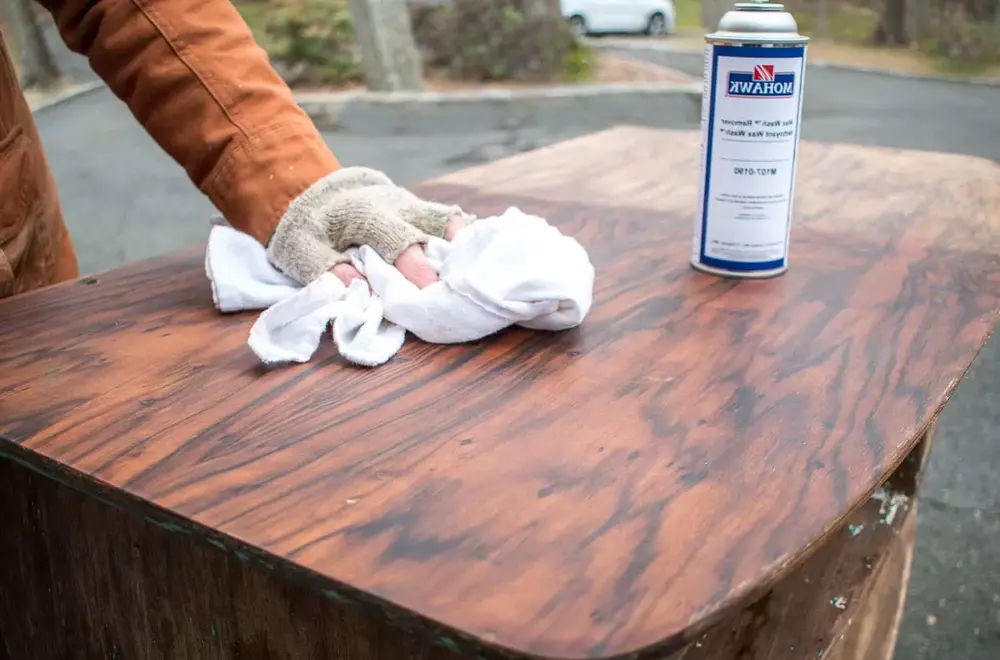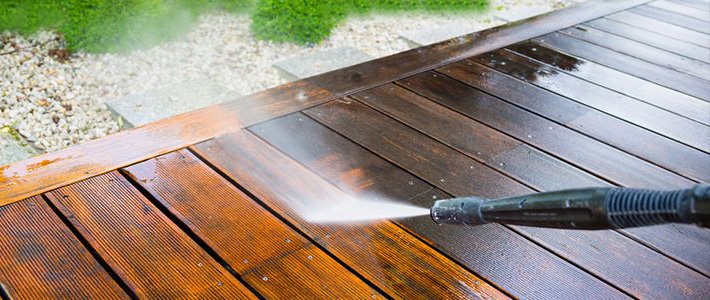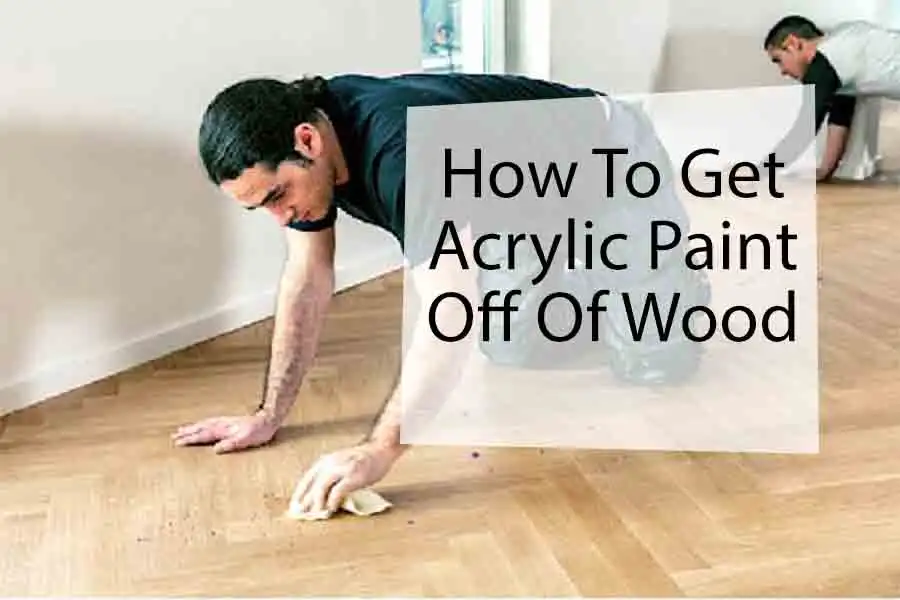Acrylic paint is a versatile and popular medium used in art. The vibrant colors, ease of use, and quick drying time make it a favorite among artists. The natural wood grain and texture of wooden surfaces make it an ideal canvas for acrylic painting.
What if you accidentally get acrylic paint on your wood furniture or flooring? Your first instinct might be to panic and start scrubbing. So how to get acrylic paint off of wood without damaging the surface?
In this guide, we will provide helpful tips and tricks to safely remove acrylic paint from wood.
7 Methods to Remove Acrylic Paint From Wood
Let’s look at some methods for removing acrylic paint from wood.

Remove acrylic paint with soap and water
Soap and water are gentle and effective methods for removing acrylic paint from wood. For a fresh stain, this method might be all you need.
Mix a few drops of dish soap with warm water in a bucket or bowl. Using a clean cloth or sponge, gently scrub the painted area in circular motions. Rinse the area with clean water and dry it with a towel.
If the paint is still present, repeat the process. This method may take a few tries to completely remove the acrylic paint.
Rubbing alcohol to remove acrylic paint
Rubbing alcohol is also an effective method for removing acrylic paint from wood. It works well on dried and stubborn stains.
This method involves using a cotton ball or cloth soaked in rubbing alcohol. Gently dab the stained area, careful not to rub too hard and damage the wood surface.
After a few minutes, use a clean cloth to wipe away the paint. You may need to repeat this process several times for tougher stains.
Vinegar to remove paint from wood
Vinegar is another gentle and natural solution for removing acrylic paint from wood. This method is safe to use on both finished and unfinished wood surfaces.
You will need a few common household items: white vinegar, warm water, dish soap, old rags or towels, and a plastic scraper or old toothbrush.
Step 1: Prepare the mixture
Mix equal white vinegar and warm water in a small bucket or container. For larger surfaces, you may need to increase the amount of solution. Add a few drops of dish soap to help lift the paint.
Step 2: Test on a small area
Before applying the mixture to a large section, testing it on a small and inconspicuous wood area is always best. This will ensure that the vinegar does not damage or discolor the wood.
Step 3: Apply the mixture
Dip an old rag or towel into the vinegar solution and wring out any excess liquid. Gently dab or rub the mixture onto the paint, covering the entire area. Let it sit for a few minutes, allowing the vinegar to penetrate and loosen the paint.
For tougher spots, you can use a plastic scraper or old toothbrush to gently scrub the area.
Step 4: Wipe away the paint
Using a clean rag or towel, wipe away the loosened paint. You may need to repeat this step a few times until all the paint is removed. Dip the rag in fresh vinegar solution to continue working on tough spots.
Step 5: Rinse and dry
Once the paint is removed, rinse the area with clean water and dry it with a towel.
Using sandpaper to remove acrylic paint from wood
If all else fails, use sandpaper to remove stubborn acrylic paint stains from wood. This method should be used as a last resort, as it can damage the wood surface.
You will need fine-grit sandpaper and a sanding block or sanding tool. Gently sand the painted area until the paint is removed.
Be careful not to apply too much pressure, or you may damage the wood. Once the paint is removed, you can lightly sand the surrounding area to blend it in.
After using sandpaper, clean the area with soap and water and then dry it thoroughly. You may also need to refinish or touch up the wood surface if any damage has occurred.
Baking soda and olive oil mixture
For a more natural approach, you can try using a mixture of baking soda and olive oil to remove acrylic paint from wood. This method works well on both wet and dry paint stains.
To make the solution, mix equal parts of baking soda and olive oil in a small bowl until it forms a paste.
Apply the paste to the painted area and let it sit for a few minutes. Then, gently scrub the paint away with a clean cloth or sponge. Rinse the area with warm water and dry it with a towel.
Using heat to remove acrylic paint from wood
Heat can also be used to remove dried acrylic paint from wood. This method works best on smaller areas and should not be used on larger surfaces.
You will need a heat gun or hair dryer for this method. Start by heating the painted area with the heat gun or hair dryer on medium-high heat, being careful not to hold it too close to the wood.
As the paint softens and bubbles, gently scrape it away with a plastic scraper or an old credit card. You may also use a rag or towel to remove the loosened paint.
After using heat, clean the area with soap and water and dry it thoroughly. This method may also require refinishing or touch-up work on the wood surface.
Commercial paint removers
If all else fails, you can use a commercial paint remover to remove acrylic paint from wood. These products can be found at most hardware or home improvement stores.
These removers typically contain strong chemicals and should be used with caution. Always read and follow the instructions carefully, and wear protective gear such as gloves and goggles.
Before using a commercial paint remover, it is recommended to test it on a small and inconspicuous wood area. You can continue using the product in the affected area without adverse effects. After removing the paint, clean the area with soap and water and dry it thoroughly.
5 Precautions Before You Start Removing Acrylic Paint
Before you start removing acrylic paint from wood, there are some precautions to keep in mind. These will help prevent further damage to the wood surface or surrounding areas.
Test in an inconspicuous area
Before applying any cleaning solution or technique, test it on a small. This will help determine if the solution is safe for your wood surface.
Avoid harsh chemicals
Harsh chemicals can strip away the finish and damage the wood. Stick to gentle cleaners and techniques.
Protect surrounding areas
Cover the surrounding areas with plastic or drop cloths if you work on furniture. This will prevent any accidental spills or splatters.
Wear protective gear
When using harsher chemicals, make sure to wear gloves and eye protection. These chemicals can be harmful to your skin and eyes.
Work in a well-ventilated area
If you are using any chemical solutions, work in a well-ventilated area. This will prevent you from inhaling any harmful fumes.
How to Prevent Acrylic Paint Stains on Wood?
While these methods can help remove acrylic paint stains from wood, it is always best to prevent them in the first place. Here are a few tips to keep your wood surfaces clean and free of paint stains:
- Always cover or protect wood surfaces before painting nearby.
- Use drop cloths or tarps to catch any spills or drips while painting.
- Clean up any spills or drips immediately with a damp cloth.
- Use painter’s tape to protect wood trims and edges before painting.
- Remove paint from brushes or rollers before applying it to the wood surface.
By taking these precautions, you can prevent the need for harsh chemicals or methods to remove paint stains from wood. And if a stain does occur, you now have several options to safely and effectively remove it.
How to Remove Paint from the Wood Deck Without Chemicals?
Wood decks are a common area to see paint spills or stains, especially if you enjoy outdoor painting projects. Luckily, there is an easy and chemical-free way to remove paint from your wood deck using water and a pressure washer.

Step 1: Gather supplies
You will need a pressure washer with an adjustable nozzle, a garden hose, and a stiff-bristled brush.
Step 2: Prep the area
Use a broom or brush to remove loose debris from the deck. This will prevent any dirt or debris from getting trapped under the paint and causing damage.
Step 3: Wet the area
Using your garden hose, wet down the painted area of the deck. This will help loosen the paint and make it easier to remove.
Step 4: Adjust the pressure washer
Adjust the nozzle on your pressure washer to a medium setting. Too high of a setting can damage the wood, while too low may not be strong enough to remove the paint.
Step 5: Start washing
Hold the pressure washer about 12 inches from the surface and wash in a circular motion. Work in small sections at a time, and continually wet the area as you go.
Step 6: Use a stiff-bristled brush
Use a stiff-bristled brush to help loosen the paint if there are any stubborn spots. Be sure not to apply too much pressure, or you may damage the wood.
Step 7: Rinse and repeat
Once the paint is removed, rinse the deck thoroughly with your garden hose. You may need to repeat this process a few times to completely remove all of the paint.
Step 8: Let it dry
Allow the deck to dry completely before using it again. You can speed up drying by using a fan or opening windows and doors for better air circulation.
Following these steps, you can safely and effectively remove paint from your wood deck without harsh chemicals. Always be cautious when using any cleaning method on wood, and stop if you notice any damage.
How to Remove Paint from Wood Trim?
Wood trims and moldings can be delicate and require special care when removing paint stains. Here is a simple method to help remove paint from wood trim without causing damage.
Step 1: Gather supplies
You will need a plastic scraper or old credit card, a clean cloth or sponge, and hot water.
Step 2: Soften the paint
Dip the cloth or sponge in hot water over the painted area. Let it sit for a few minutes to soften the paint.
Step 3: Scrape away the paint
Once the paint has softened, use the plastic scraper or old credit card to gently scrape it away. Be sure to work slowly and carefully to avoid damaging the wood.
Step 4: Repeat if necessary
You may need to repeat this process a few times for stubborn areas of paint. Just be sure not to apply too much pressure when scraping.
Step 5: Clean the area
Once the paint is removed, clean the area with a mild soap and warm water. Use a clean cloth to wipe away any residue or leftover paint.
Step 6: Dry and touch-up
Finally, dry the area thoroughly and touch up any missed spots with a matching finish or paint color.
Following these steps, you can safely remove paint from wood trim without damaging the delicate surface.
Acrylic Paint Removal Methods for Wooden Cabinets
If you are wondering how to remove paint from wood cabinets? Acrylic paint is known to be quite difficult to remove once it has dried. Here are some of the most common ways to remove acrylic paint from wood cabinets:
Using sandpaper to remove acrylic paint
Sandpaper is a great option for removing acrylic paint from wooden cabinets. First, gently sand the painted area with grit sandpaper (around 120 to 220). Be careful not to apply too much pressure, which could damage the wood. Continue sanding until you see the paint starting to come off. Once that happens, switch to finer grit sandpaper (around 320 or higher) and continue sanding until the paint is completely removed.
Using denatured alcohol to remove acrylic paint
Denatured alcohol is a strong solvent that removes acrylic paint from wooden cabinets. Simply apply the alcohol onto a clean cloth and gently rub it onto the painted area. Repeat this process until the paint starts to come off. Be sure to wear gloves and work in a well-ventilated area, as denatured alcohol can be harsh and cause skin irritation.
Using a heat gun to remove acrylic paint
A heat gun is another method to remove acrylic paint from wooden cabinets. First, set the heat gun on low or medium heat and hold it about 6-8 inches from the painted area.
Move the heat gun back and forth over the painted area until the paint starts to soften. Once it becomes pliable, use a scraper to gently scrape off the paint. Be careful not to hold the heat gun too close or too long, as this could damage the wood.
Using a chemical stripper to remove acrylic paint
If the above methods do not work, you can try using a chemical stripper specifically designed for removing acrylic paint. You can find these at most hardware stores, and they come with detailed instructions on how to use them. Be sure to follow the instructions carefully and wear protective gear such as gloves, goggles, and a mask when using chemical strippers.
Yes, acrylic paint can be washed off with soap and water while the paint is still wet. The water-soluble nature of acrylic paint allows for easy removal from surfaces. When dried, it becomes water-resistant and cannot be washed off easily.
No, acrylic paint does not damage wood as it is non-toxic and safe for use on various surfaces, including wood. The durability and versatility of acrylic paint make it popular for wood crafts and projects.
A razor blade or scraper can gently scrape off the dried paint for non-porous surfaces like glass or plastic. A mixture of hot water and laundry detergent on fabric or carpet can help loosen and remove the paint. Sanding down the dried paint with sandpaper is the best option for wood surfaces.
Acrylic paint is water-resistant when dried but not completely waterproof. The paint may peel or crack over time if exposed to excessive moisture or water. You can apply sealant over the top of the dried paint to make acrylic paint more waterproof on wood.
Acrylic paint is permanent on wood as it adheres well and does not easily chip or flake off. However, the color may fade or wear off over time due to exposure to sunlight and other elements. Sealants can help protect the paint and make it last longer on wood surfaces.
Vinegar is a natural cleaning agent to remove wet or dried acrylic paint from surfaces. Vinegar can help break down the pigments when the paint is still wet. When dry, vinegar can soak and loosen the paint before scraping it off. However, it may take multiple attempts and some scrubbing to completely remove the paint.
Summary (How to get acrylic paint off Of wood?)
Acrylic paint has been widely used since the middle of the 20th century and is still popular today. It’s a versatile, durable, and affordable medium for artists, DIY enthusiasts, and professionals alike.
However, accidents happen, and spills are sometimes inevitable. If you happen to get acrylic paint on your wooden surfaces, don’t panic. With the right techniques, you can easily remove acrylic paint from wood without causing any damage.
This guide on getting acrylic paint off wood has hopefully provided you with the necessary knowledge and tips. Remember to always act fast, use gentle methods, and test your chosen method on a small inconspicuous area first. You can successfully remove acrylic paint from wood surfaces and restore their natural beauty with patience and persistence.


8 thoughts on “How To Get Acrylic Paint Off Of Wood?”